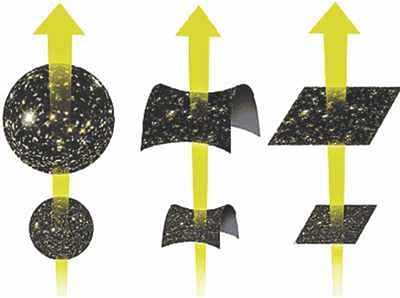Is the Universe closed or open?

Out of the many unresolved problems in cosmology, the one that has confounded astronomers most is: "What is the shape of the Universe?" It may sound like an abstract topic apt for metaphysicists or their ilk; but a precise knowledge of the shape is essential in determining the size, age, and eventual fate of the Universe.
The shape depends on the difference between the cosmological and critical densities of the Universe. The critical density is the dividing line between eternal expansion and eventual collapse. Its value is of the order of 10-29 grams per cubic centimeter. If the cosmological density is greater than the critical density, the Universe is "closed" with a spherical surface. If they are equal, the Universe is "flat." If it is less than the critical density, the Universe is "open" and the shape will be hyperbolic, like a saddle.
The red shifted wavelength of radiation from distant supernovae affirms that space in the Universe is expanding at an accelerated rate, with the outermost regions moving farther away with high velocities. Red shift is change in the wavelength of light/radiation from lower to a higher value when the source is receding from the observer. As a result of the expansion, high-energy radiation from the early Universe got red-shifted to cold, low-energy, long wavelength microwaves copiously streaming all over the space. This is known as the cosmic microwave background radiation (CMBR). It is the "genetic code" of the Universe.
The shape of the Universe is inferred from an analysis of CMBR of the distant Universe taken by NASA's Wilkinson Microwave Anisotropy Probe (WMAP) spacecraft. It points to a spatially flat Universe that will expand forever. However, the expansion will gradually slow down, not accelerate as observations have shown.
How does the calculated density, and hence the predicted shape, compare with the observed shape? The most direct method of calculating the density involves counting nearby galaxies in some randomly selected volume of space, add up their masses, and divide by the total volume. The volume is taken as a sphere whose radius is given by the red-shift from the edge of the space under consideration. This technique yields extremely low values for the density, only a small percentage of the critical density suggesting that the Universe is open. An open Universe has insufficient matter for gravity to halt its expansion. It will keep on expanding at a constant rate forever.
The above method excludes the mass equivalent of energy which are related by Einstein's equation E=mc2. The total amount of mass-energy in the Universe can be determined by analyzing CMBR. Their inclusion in the calculation of the density still points to an open Universe.
It is also likely that substantial quantity of matter may have been overlooked in calculating the mass. Indeed, measurements using more sophisticated techniques yield much higher values than the estimated total mass of the visible galaxy clusters. The amount is still not enough for a flat or a close Universe.
The shortfall of matter required to close the Universe or make it flat and propel its never-ending expansion led cosmologists to invoke the existence of "dark matter," a mysterious, invisible substance that permeates the vast space. The undetected dark matter could take several different forms black holes, dead low-mass stars, or yet to be discovered theoretically predicted photinos and axions. It is estimated that there are ten times as much dark matter as visible matter. If dark matter is taken into account, the density increases ten-fold, but it is still less than the critical density.
To add to our bewilderment, density is decreasing because the volume of the Universe is increasing due to expansion, but mass is not. What next? We hedge our bet on the neutrino. Recent experiments indicate that the millions of neutrinos in every cubic centimeter of the Universe, till now thought to be massless may have mass after all, though miniscule in amount. But a precision measurement of its mass is turning out to be extremely difficult. If neutrinos do not have sufficient mass, we have to wait for new generation of particle accelerators to discover photinos and axions and hope they are massive enough to at least flatten the hyperbolic Universe. If that fails, we are ingenious enough to develop new esoteric models and methods until the Universe becomes flat or spherical. According to Stephen Hawking, "We are just an advanced breed of monkeys on a minor planet of a very average star. But we can understand the Universe. That makes us something very special."

 For all latest news, follow The Daily Star's Google News channel.
For all latest news, follow The Daily Star's Google News channel. 



Comments